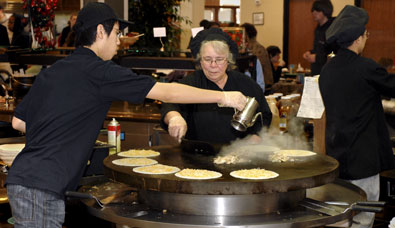Inside Iowa State
Inside ArchivesSubmit newsSend news for Inside to inside@iastate.edu, or call (515) 294-7065. See publication dates, deadlines. About InsideInside Iowa State, a newspaper for faculty and staff, is published by the Office of University Relations. |
Feb. 29, 2008 
ISU Dining staff prepare made-to-order quesadillas for a lunch option in the Marketplace dining complex of the Union Drive Community Center. Photo by Bob Elbert. Dining's (r)evolutionby Anne Krapfl A made-to-order omelet bar. Nutrition information charts. Fresh pizza-stone pizzas. Ice cream to go. Help-yourself dessert spreads. Fresh stir fry. Burgers grilled to your liking. Three-and-a-half hours to squeeze in lunch. Made-to-please dining centers are part of keeping students happy at Iowa State. It hasn't always been so sweet. Remember when there were restrictions on seconds, the cafeteria was open an hour or two, and milk, coffee and water were the only beverages? In this sesquicentennial year, Inside looks back at some earlier traditions and experiences in student dining. Ghostly fareComplaints about the food, regardless of its actual quality, are a timeless tradition. One of the earliest recorded incidents occurred in May 1894, on the front lawn of Old Main (current location of Beardshear; destroyed by fire in 1902). College trustees chatting on the front porch after dinner were visited by sheet-clad student "ghosts" bemoaning their various deaths -- all due to the indifference of the college cook -- and predicting others would join them soon enough. As they prepared to complete their performance, they were interrupted by another white-clad figure among them, whose voice was quite familiar to everyone present: president William Beardshear. He "invited" the students to a meeting in his office the next morning. Something from homeIn 1983, students going home for spring break were encouraged to bring back their favorite recipes from mom's or grandma's kitchen. More than 200 submissions were turned in and tested over the summer months. During the following academic year, 19 winners -- including sandwiches, casseroles, vegetables and desserts -- were served on a rotating basis in the residence cafeterias. Do it yourselfStudents' financial duress during the Great Depression led to a cooperative program, in which students did the cooking, dishwashing and other labor required to serve meals in their residence dining room. Staff from the home economics program advised them on menus and purchasing. In February 1936, 300 students participated in such a program. The need for it ceased with the end of World War II. December traditionThe female residents of Lyon Hall took part in the first White Breakfast in December 1918. Clothed in white dresses or blouses and carrying lit candles, the residents paraded to their dining room for Sunday breakfast singing Christmas carols. The tradition spread to all the women's dormitories, and was held on the Sunday before winter final exams. The practice continued into the early 1960s. Have anotherThe popular tradition of Banana Split Night in the residence dining centers during finals week started in 1969 and continued into the 1980s. Part of the novelty was that students could have as much ice cream and toppings as they wanted (well before the days of all you can eat). Dressing for dinnerThrough 1969, dining centers enforced dress codes, including special rules on Sundays (when heels and hose for women, dress shirt and tie for men were recommended). The rules greatly relaxed in 1970 with a vastly simplified code: 1. Shoes and shirts required 2. Sleepwear, swimwear and gym attire not acceptable. In 1980, "gym attire" was dropped from the list of no-nos. Get in lineThe opening of Linden Hall in 1957 launched the university's transition from served dinners to cafeteria-style dining. In the beginning, Linden's cafeteria line was used for breakfast and lunch; student-employees continued to serve sit-down dinners. The necessity, in 1965, for 300 men from the brand-new Storms Hall to eat at Linden until their dining center was complete compelled residence leaders to switch dinners there to cafeteria lines as well. Dining centers that were constructed or renovated after this also featured cafeteria lines, and by the late 1960s, this was the standard. Keeping up with the timesSome other key additions to dining centers included:
It's just foodFormer food service director Thomas Welch told an Iowa State Daily reporter in October 1977: "We don't try to kid anybody about what we do. We're not trying to be a hotel or a club. Food Service merely tries to provide the most well-balanced meals it can for the student away from home." Breakfast = better gradesRoy Butler, the assistant dietitian for the Towers complex in 1966, announced a standing bet that anyone who ate a good breakfast every morning would bump his or her GPA for the quarter by 0.3 points. After two quarters, no one had taken those odds and the offer seemed to fade away. |

Sesqui seriesInside is celebrating the sesquicentennial with a yearlong series of photos and articles that look back at Iowa State traditions, people and places. |